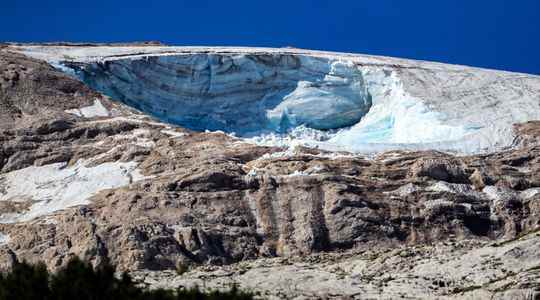A fiery cloud hurtling down the slopes of an ice volcano at 300 km/h. Such is the feeling experienced at the sight of the images of the disaster, filmed live from a nearby refuge. This Sunday, part of the Marmolada glacier, the largest in the Italian Alps, collapsed, causing the death of at least six people and injuring eight, while waiting to find the missing. It was at one of the peaks of the massif, Punta Rocca, that the fracture occurred, resulting in an avalanche on a well-known hiking route.
“The Queen of the Dolomites”, as the Marmolada is nicknamed, ended up cracking, under the effect of a thermometer mounted much too high, up to ten degrees at the top the days preceding the rupture. “The collapse is the consequence of the current meteorological conditions, that is to say an episode of early heat which coincides with the problem of global warming”, explained to AFP Massimo Frezotti, professor at the University of Rome. . “We had an extremely arid winter, with a 40-50% rainfall deficit, so current glacier conditions are mid-August, not early July.”
Melting ice, an identified threat
As a result of this excessively mild climate, the melting of the layer of ice known as permafrost (also called permafrost), the term used to designate the ground remaining frozen, has accelerated. This accumulation of water under the glacier would then have caused the stalling of a block, then the release of an immense quantity of water dragging everything in its path, as illustrated by the images. The event is not in itself unprecedented.
In May, a serac fell off in the Swiss Grand-Combin massif, causing the death of two mountaineers. But the case of the Marmolada is significant, the scientists noting each year a very clear decrease in the snow cover of the massif. And for good reason, the minimum altitude at which the ground is supposed to freeze continues to increase. This year, it was measured at 4,000 meters above sea level, higher than the summit, which rises to 3,343 meters.
A study by the Italian research center Eurac Research also warns that without an immediate reduction in our greenhouse gas emissions, the number of snow days counted at 1,500 meters above sea level in the French Alps could more than halve by the end of the century. A more general warning comes from the IPCC in its March 1 report, which ranks the increasing melting of glaciers among the ten threats caused by global warming. And if there is still time to act to reverse the trend, one figure makes you dizzy: the rate of ice melting has increased by 65% over the last thirty years.
